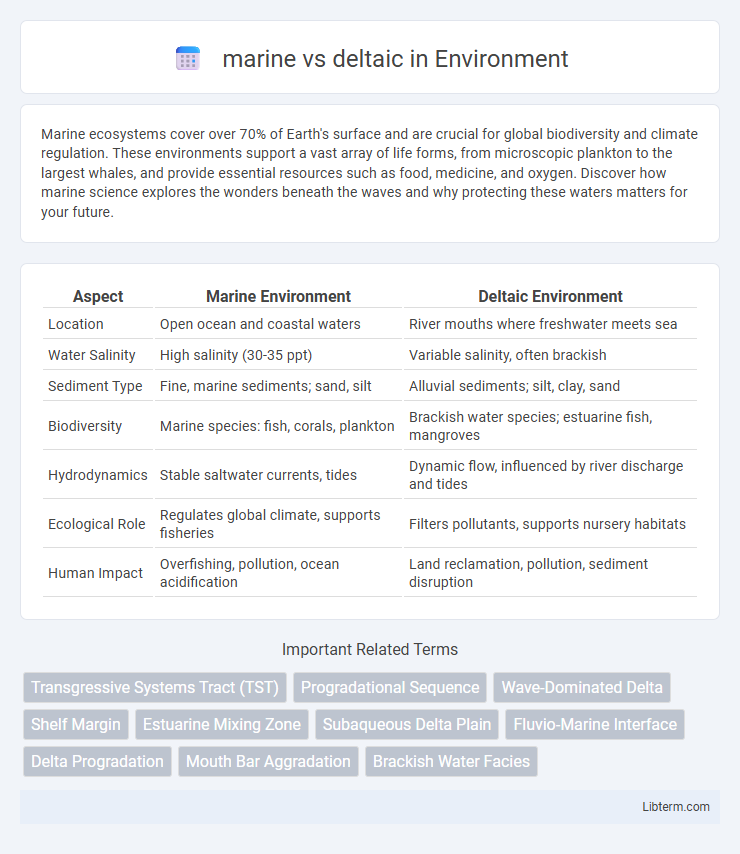Marine ecosystems cover over 70% of Earth's surface and are crucial for global biodiversity and climate regulation. These environments support a vast array of life forms, from microscopic plankton to the largest whales, and provide essential resources such as food, medicine, and oxygen. Discover how marine science explores the wonders beneath the waves and why protecting these waters matters for your future.
Table of Comparison
| Aspect | Marine Environment | Deltaic Environment |
|---|---|---|
| Location | Open ocean and coastal waters | River mouths where freshwater meets sea |
| Water Salinity | High salinity (30-35 ppt) | Variable salinity, often brackish |
| Sediment Type | Fine, marine sediments; sand, silt | Alluvial sediments; silt, clay, sand |
| Biodiversity | Marine species: fish, corals, plankton | Brackish water species; estuarine fish, mangroves |
| Hydrodynamics | Stable saltwater currents, tides | Dynamic flow, influenced by river discharge and tides |
| Ecological Role | Regulates global climate, supports fisheries | Filters pollutants, supports nursery habitats |
| Human Impact | Overfishing, pollution, ocean acidification | Land reclamation, pollution, sediment disruption |
Overview: Marine and Deltaic Environments
Marine environments are characterized by open ocean conditions with high salinity, marine fauna, and sediment deposition driven by wave and tidal actions. Deltaic environments form at river mouths where freshwater mixes with seawater, creating distinct sedimentary processes dominated by fluvial input and delta progradation. The primary sediment types differ, with marine settings favoring finer carbonate and clastic sediments, while deltaic systems accumulate coarser, often sand-rich deposits influenced by river discharge dynamics.
Key Characteristics of Marine Depositional Systems
Marine depositional systems are characterized by fine-grained sediments, such as clays and silts, which accumulate in low-energy environments like continental shelves and deep ocean basins. These systems often display well-sorted sediments with biogenic components like shells and carbonate minerals, indicating marine life activity. In contrast to deltaic deposits, marine systems lack extensive fluvial sediment influx and show distinct sedimentary structures formed by wave and tidal actions.
Key Features of Deltaic Depositional Systems
Deltaic depositional systems are characterized by sediment accumulation at river mouths where freshwater meets marine environments, typically forming distinct sub-environments such as distributary channels, interdistributary bays, and delta plain wetlands. These systems exhibit high sediment supply from fluvial sources, variable energy conditions, and complex stratigraphy including coarsening-upward sequences and abundant organic-rich layers. Unlike marine settings dominated by wave and tidal processes, deltaic systems display dynamic interactions of fluvial, wave, and tidal forces, resulting in heterogeneous lithofacies and pronounced vertical and lateral facies changes.
Sediment Sources and Transport Mechanisms
Marine sediment sources primarily include continental weathering products, biogenic material, and authigenic minerals, transported by ocean currents, waves, and tidal actions. Deltaic sediments are largely derived from riverine input, including fluvial sands, silts, and clays, transported via river discharge, distributary channels, and delta-front currents. The transport mechanisms in marine settings emphasize longshore drift and deep-water turbidity currents, whereas deltaic environments rely heavily on fluvial sediment flux and localized wave reworking.
Depositional Processes: Marine vs Deltaic
Marine depositional processes are dominated by wave action, tidal currents, and deepwater sedimentation, resulting in well-sorted, fine-grained sediments typically deposited in continental shelf and slope environments. Deltaic depositional processes are characterized by the interplay of riverine sediment load, distributary channel migration, and periodic flooding, leading to heterolithic sequences with coarser, often poorly sorted sands, silts, and clays. Sediment deposition in marine settings tends to be more uniform and influenced by marine transgressions and regressions, whereas deltaic deposits show pronounced vertical and lateral facies changes due to delta progradation and avulsion.
Facies and Stratigraphic Differences
Marine facies typically exhibit fine-grained sediments such as shales, limestones, and marine fossils, reflecting deposition in relatively deep, stable environments with low to moderate energy conditions. Deltaic facies are characterized by coarser sediments including sands and silts with channel, delta front, and prodelta subdivisions, indicating higher energy fluvial-marine interactions and rapid sedimentation rates. Stratigraphically, marine sequences often show continuous, parallel bedding with transgressive-regressive cycles, while deltaic sequences display complex interfingering of coarsening-upward units, prograding clinoforms, and frequent unconformities related to fluctuating sediment supply and relative sea level changes.
Biological and Ecological Influences
Marine environments typically exhibit high biodiversity due to stable salinity, nutrient availability, and complex habitats such as coral reefs that support diverse biological communities. Deltaic systems experience dynamic sediment deposition and freshwater influx, creating nutrient-rich conditions fostering dense vegetation, estuarine species, and critical nursery habitats for fish and invertebrates. Ecological influences in marine versus deltaic settings differ in salinity gradients, sedimentation patterns, and nutrient cycles, shaping distinct biological assemblages and ecosystem productivity.
Economic Significance: Marine vs Deltaic Sediments
Marine sediments support offshore oil and gas reserves crucial for global energy markets, with extensive deposits of hydrocarbons trapped in deepwater basins. Deltaic sediments are fertile and rich in organic material, making them vital for agriculture and fisheries, driving economic activities in coastal regions. The exploitation of marine sediments for minerals like polymetallic nodules offers emerging economic potentials, whereas deltaic sediments sustain dense populations through natural resource availability and ecosystem services.
Challenges in Differentiating Marine and Deltaic Deposits
Challenges in differentiating marine and deltaic deposits arise due to overlapping sedimentary features such as similar grain sizes, fossil assemblages, and sedimentary structures. Marine deposits often exhibit well-sorted sandstones with marine fossils and wave ripple marks, while deltaic deposits show heterogenous sediments, fluvial channel structures, and terrestrial organic material. Diagenetic alterations and transgressive-regressive cycles further complicate the distinction by altering primary sedimentary characteristics and creating facies intertonguing.
Environmental Impacts and Management Strategies
Marine and deltaic environments exhibit distinct environmental impacts due to their unique hydrodynamic and sedimentary processes affecting ecosystem health and biodiversity. Marine settings face challenges from ocean acidification, overfishing, and pollution, requiring management strategies such as marine protected areas (MPAs), sustainable fisheries policies, and pollution control regulations. Deltaic regions are impacted by river sediment loss, land subsidence, and nutrient loading, necessitating integrated water resource management, sediment replenishment programs, and wetland restoration efforts to maintain ecological balance and support local communities.
marine Infographic

 libterm.com
libterm.com